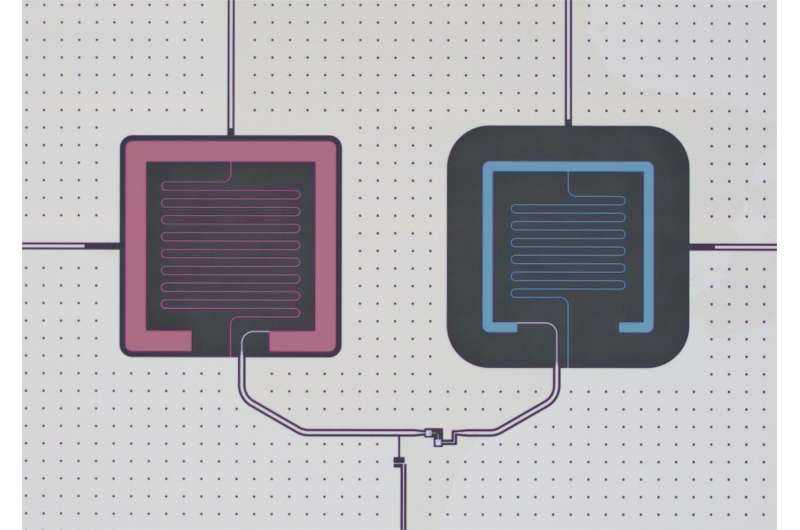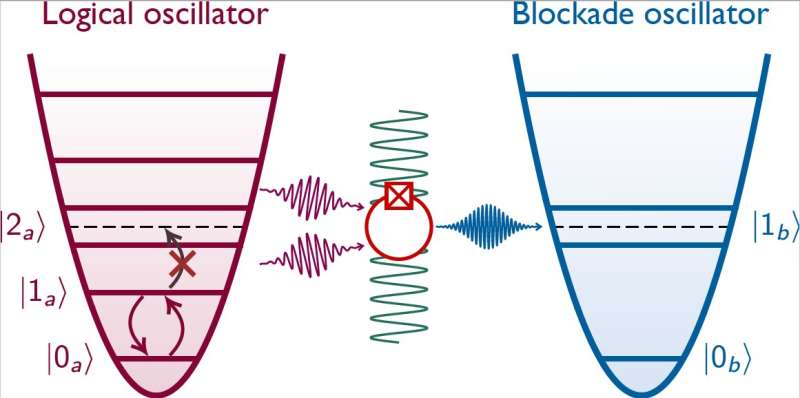December 4, 2019 feature
Researchers achieve quantum control of an oscillator using a Josephson circuit

Superconducting circuits, which have zero electrical resistance, could enable the development of electronic components that are significantly more energy-efficient than most chips used today. Importantly, superconducting circuits rely on an electronic element known as the Josephson junction, which allows them to manipulate quantum information and mediate photon interactions. While past studies have tried to enhance the performance and coherence of Josephson circuits, so far, the most promising results in terms of photon lifetimes were achieved in microwave cavities.
A team of researchers at Princeton University, Northwestern University and the University of Chicago have directly operated an oscillator using a stimulated Josephson nonlinearity. In their paper, published in Nature Physics, the team achieved quantum control of an oscillator by operating it as an isolated two-level system, tailoring its Hilbert space.
"Our research was motivated by the ongoing effort in the superconducting circuits community to engineer highly coherent qubits for quantum information," Prof. Andrew Houck, one of the researchers who carried out the study, told Phys.org. "There has been enormous progress in designing linear microwave resonators that can outperform the coherence of conventional superconducting qubits."
Prof. Houck and his colleagues have been trying to come up with clever strategies to engineer microwave cavities as effective two-level systems. The method they proposed in their paper could allow researchers to harness some of the properties of these cavities, including their improved photon lifetimes, by introducing a new kind of nonlinearity.

"We achieve control over the quantum states encoded in the single excitation sector of the oscillator by perturbing the higher energy levels of the harmonic ladder," Prof. Houck explained. "The key ingredient is employing the Josephson junction as a wave-mixing element to hybridize the oscillator's two-photon state with the one-photon state of an ancillary mode."
By implementing a flux-tunable inductive coupling between two resonators, Prof. Houck and his colleagues selectively Rabi drove the lowest eigenstates. This was the result of the dynamic activation of a three-wave interaction via a process known as parametric flux modulation.
"It was encouraging to see that the experimental observations perfectly matched our theoretical predictions for what the nonlinearity would do to the oscillator's energy spectrum and that the nonlinearity itself has no detrimental effect on the induced qubit lifetime," Andrei Vrajitoarea, another researcher who carried out the study, told Phys.org. "From a hardware perspective, microwave resonators are a cheaper resource compared to Josephson junction circuits."
The new approach for controlling oscillators introduced by Prof. Houck, Vrajitoarea and their colleagues could have important implications for the development of new architectures for quantum information and simulation with superconducting circuits. Their work ultimately offers an alternative and highly promising path for engineering a variety of highly coherent anharmonic oscillators in a hardware efficient manner, using a single Josephson coupler circuit.
"One obvious path moving forward is to implement this nonlinearity in a highly coherent 3-D cavity and study the reduction in losses," Vrajitoarea said. "We are also excited about exploiting this nonlinearity for stimulating and controlling photon interactions in a lattice of coupled cavities as a platform for simulating strongly correlated quantum materials."
More information: Andrei Vrajitoarea et al. Quantum control of an oscillator using a stimulated Josephson nonlinearity, Nature Physics (2019). DOI: 10.1038/s41567-019-0703-5
Journal information: Nature Physics
© 2019 Science X Network


















